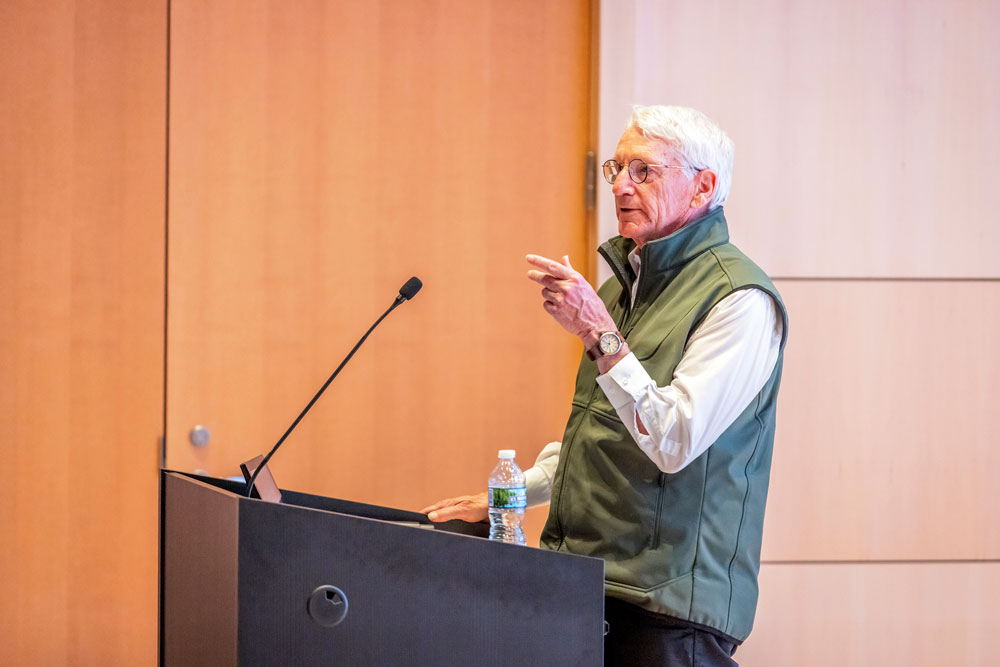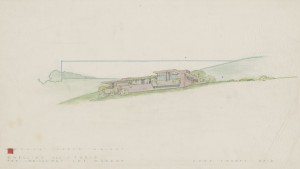Any drive to Gambier involves cruising through rolling countryside filled with charming farm houses, rustic barns, two-rail fences — and one Frank Lloyd Wright home.
Well, almost.
The famous architect — recognized as the greatest of all time by the American Institute of Architects — actually designed a house for a local photographer and his family in 1946 just a mile west of campus. It was meant to sit near the top of a wooded hill overlooking the Kokosing River valley on the south side of Route 229.
But it was never built.
Uncovering the details of that house — and the story behind it — became a passion project for Professor Emeritus of Art Greg Spaid ’69 H’21. His findings are the foundation of an ongoing exhibit at The Gund titled “To Dream a House: Frank Lloyd Wright in Knox County, Ohio,” which was put together with help from student interns at the museum.
“It’s a beautiful setting. It sort of sees the whole valley,” Spaid said of the proposed location for the house. A former provost, Spaid’s own art is in the Museum of Modern Art in New York City, the Smithsonian Museum of American Art in Washington, D.C., and elsewhere.

Spaid first learned about the house in 1998 when he met the late Joe Munroe, a noted agricultural photographer whose early work with The Farm Quarterly magazine led him to settle in Knox County. Munroe spoke of his family’s dream house that was commissioned and completely designed, but which he never had the money to construct.
All that’s left of that dream are 24 drawings by Wright, facsimiles of which are on display at The Gund through July 31 on loan from the Avery Architectural & Fine Arts Library at Columbia University in New York City. They are accompanied by the photography by Munroe, who lived in Knox County from 1946-1955, and information about the Walkers, a local sheep-farming family he chronicled in his first assignment here.
The exhibition was developed as part of the Gund Associates program, a paid student internship opportunity offering hands-on training in museum work under the supervision of the professionals of Kenyon’s academic museum, The Gund. Students researched correspondence between Munroe and Wright about the house project as well as the architectural and cultural context of Wright’s work and information on Munroe’s life, according to Robin Goodman, exhibitions and collections registrar at The Gund.
“With this new original research in hand, they developed and built an accompanying website to present this information to exhibition visitors as well as the broader public,” Goodman said. “In addition, they gained practical skills by assisting our Exhibitions and Collections Preparator Taylor Smith in the framing of the drawings for the exhibition.”
Spaid’s desire to learn more about the Knox County Wright house took him across the country over the years — from the architect’s studio and foundation at Taliesin West in Arizona to the Getty Center in Los Angeles — as he sought out drawings and correspondence.
“It just got stuck in my imagination,” he said. “It involves some stories that are little known about Gambier.”
Munroe knew Wright from work he did earlier in his career photographing homes designed by the architect in Michigan, and they took a liking to each other. So when Munroe and his wife, Virginia, reached out saying how wonderful it would be if Wright would design the couple’s central Ohio home, they received a brief but positive response: “Why not?”
The plans remain noteworthy examples of Wright’s Usonian style, intended for middle-class families, according to Spaid. They feature the strong horizontal lines that he favored as well as natural lighting, radiant heating, a carport and a location at the brow of a hill, not the top. (A much more unusual feature is the inclusion of a darkroom.)
While a different home has since been built on the site, a house constructed using these designs in a similar location would be considered an official Wright home, he said. The only hitch? Spaid estimates it might cost more than $1 million to build it today in Knox County.
The exhibition is on display in the Meier-Draudt Curatorial Classroom on the first floor of The Gund and is accessible weekdays from 9 a.m. to 5 p.m. through July 31. Upcoming special events include a panel discussion involving Harlow Walker, Jodi Kovach, Goodman and Spaid on May 23 at 2 p.m. in the Community Foundation Theater and a cyanotype activity inspired by Wright at The Annex in Mount Vernon on May 24 at 3 p.m..
